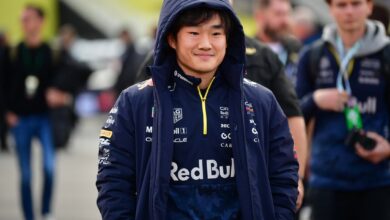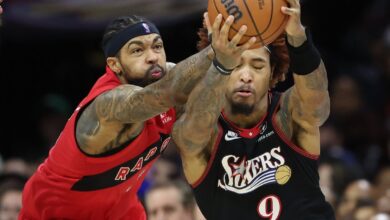
Let’s take a look at a few of the comments after Steph Curry and Sabrina Ionescu squared off in a 3-point shooting contest on Saturday night, Curry topping the Liberty star by just 3 points, 29-26, both shooting from the NBA arc.
“I didn’t back down from the challenge and going up against the best shooter this game has ever seen,” Ionescu told Malika Andrews.
“She wasn’t afraid of the moment she wasn’t afraid of the stage and she backed it up,” Curry said.
And then…
“She should have shot from the 3-point line that the women shoot from,” Kenny Smith said on the TNT broadcast, right as Ionescu and Curry were embracing on the court.
And then he said it again. And again.
You don’t have to put on the pom-poms for Ionescu or women’s sports, but too many broadcasters are happy to communicate that women’s participation, or records, or fandom is somehow less than. That’s not apathy, it’s full-on shade.
And if Ionescu had, as Smith posited, shot from the WNBA arc and beat Curry, it would not have brought the respect that tying the All-Star 3-point champ Damian Lillard did on the same court. But for someone who wants to discount Ionescu, there is no arc, ball, shoe, night, or opponent that would have been just right for the discount crew. They just don’t like porridge, period.
Smith was wrong for the time and place to air his grievance, but there’s also what it cost TNT to be able to give these competitors their moment and win over curious viewers who tuned in to see this event.
“We needed a woman on the headsets, too,” Sue Bird posted on social media. “So much nuance and storytelling missed. 26 is 26, tho (fire emoji)”
Bird is spot on. Why on earth don’t you call in someone like Candace Parker, who has played in the WNBA and covered both leagues as a broadcaster, to offer the nuance and context a game like this deserves? There are any number of people equipped, like former Knicks broadcaster, Liberty player, and Pelicans VP of basketball operations Swin Cash, or 76ers broadcaster Kate Scott.
You have new fans tuning into the spectacle of an event like this, and instead of converting them into regular viewers, these networks are sending a clear message — you can watch, but you are still an outsider.
Any woman who has listened to a broadcast or sports talk radio where a male host starts using dating comparisons to talk about players knows what I mean. For example, you don’t marry a 10, but he’s a reliable point guard blah blah blah. The conversation makes you aware that they’re not talking to you, they’re talking to him. He’s the audience, you just happen to be there.
This unfortunately isn’t an isolated incident. Check out the Super Bowl broadcast this year on CBS. Plenty of fans were waiting for the moment that Travis Kelce, fresh off his second straight championship, reunited with Taylor Swift in the celebration. The announcers on the feed ignored that moment as it happened in front of them to discuss some “statistical-wise” stuff and then, inappropriately for the moment, the death of Norma Hunt — before Nate Burleson piped up and apologized for getting to the point for many viewers. “I know we want to talk about football right now, but as I look at Travis Kelce and Taylor Swift…”
Catharsis isn’t getting in the way of the football. The game is over. You’re not above noticing what’s actually happening.
Fox Sports insists on using Alexi Lalas for the Women’s World Cup games, and last summer he called the women’s team “unlikeable” and “polarizing.” Why would he turn down the paycheck, but he doesn’t add value as an analyst and hasn’t won enough internationally to justify the lifetime appointment he seems to have been granted? Is that really the best Fox can do?
Then there is Jay Williams, who had to take Caitlin Clark’s record-breaking moment and make it about himself — saying she wouldn’t be a truly great player until she won an NCAA national title. It’s worth noting here that Williams went to a plucky little program called Duke, while Clark picked a basketball juggernaut called Iowa. Oh wait, reverse that. Williams went to a tournament perennial, while Clark created one.
Whenever I would prep to do sports talk radio or First Take or Sports Reporters, I’d cram like I was about to take the SAT. What were the stats, what was the context? The last thing you want is to be called out for not knowing something or getting it wrong, and it happens.
So I can tell you. These commentators aren’t doing the work.
They do work where they want to — I’m sure they know a lot about the men they cover and watch, but are they putting in that same work on the women’s side? And if they are, then they are doing a terrible job of being able to call that moment.
Smith really blew it, making the moment about his lame opinion rather than being a broadcaster. As the crowd cheered and Curry and Ionescu hugged, Smith was going on with some look-at-me-nonsense about the size of the WNBA ball and the placement of the arc.
Like with the failure of the CBS crew during the Super Bowl, you are calling not just a competition, but an event. What are we looking at? Put it in context. Actual context, Kenny, not the stereotypes and biases cluttering your brain.
This wasn’t the first cross-over event to garner Battle of the Sexes attention. Golfer Annika Sorenstam played The Colonial in 2003 and her Thursday round set a new record for USA Network on the first day of a PGA tournament. Danica Patrick had a similar impact on racing. These are moments when there is audience to be gained for a sport. Even when it looked like the NFL couldn’t possibly be more of a monolith, Taylor Swift starts coming to games and all of a sudden it became the most-watched Super Bowl in history and the percentage of women in the audiences goes up to 48 percent. Heck, Billie Jean King was able to boost the WTA after beating Bobby Riggs in 1973. Some would argue that match set the conditions for the modern era of women’s sports.
These events cross-pollinate fan bases, and that means a lot for the WNBA given that there is more room to grow. But whether it’s the US Open or the Olympics, having men and women in one place to compete is good for all participating athletes.
On Monday morning the ratings came out. The game drew 5.4 million viewers, highest total in the last four years, and peaked during the Ionescu-Curry shootout.
“Thank you for putting a spotlight on the men’s game.” Malika Andrews quipped to Ionescu after the interview, prompting a laugh from the Liberty guard.
And that’s how you work a broadcast like this.
Source link




